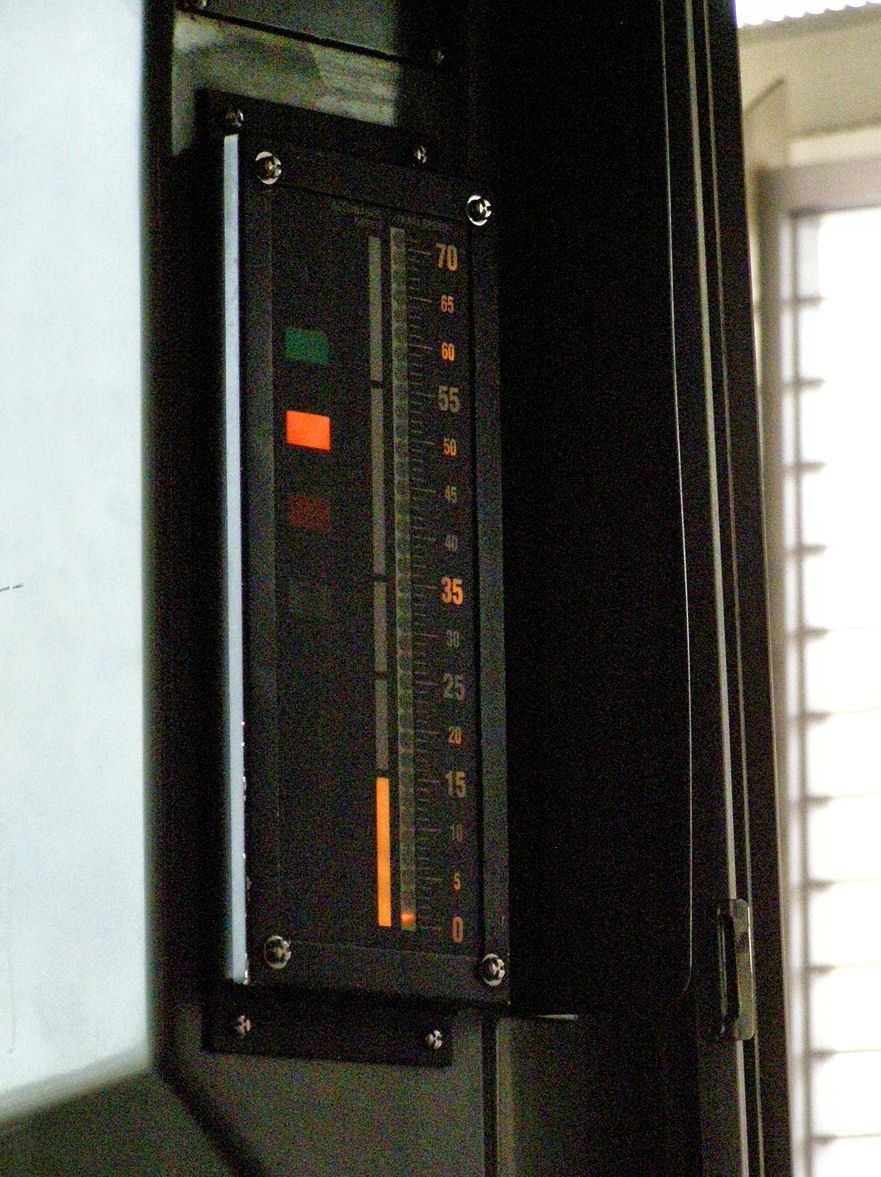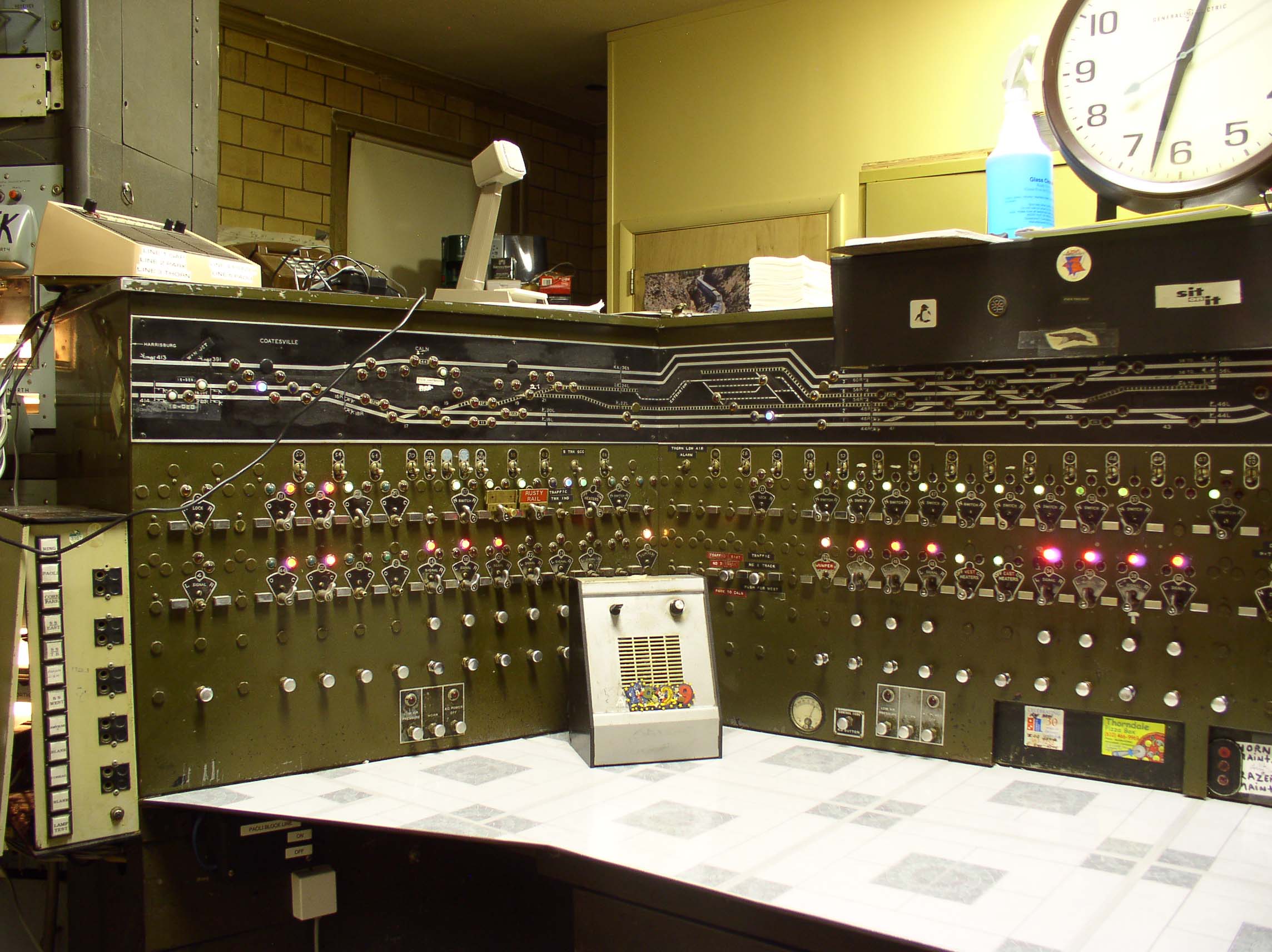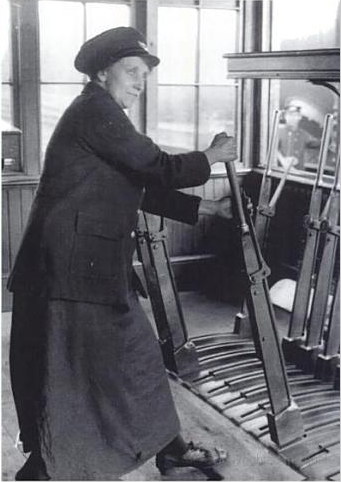|
Continuous Automatic Warning System
The Continuous Automatic Warning System (CAWS) is a form of cab signalling and train protection system used in Ireland to help train drivers observe and obey lineside signals. CAWS has been in use on Iarnród Éireann diesel trains since 1984. All NIR trains operating cross-border must also be fitted with CAWS. Coded track circuits, which form the basis of the system (see below), are installed on all Dublin Suburban and Intercity routes to Cork, Limerick, and Athlone and as far as the border on the Belfast line. This system is of American origin, being originally supplied by US&S, then a division of Westinghouse Air Brake Company (WABCO). Current equipment is supplied by SASIB, a division of Alstom. Principles of operation CAWS repeats the aspects shown by the lineside colour light signals on an aspect display unit (ADU) inside the driver's cab. The ADU continuously displays the aspect that was shown by the previous signal until updated about 350 metres before the next sig ... [...More Info...] [...Related Items...] OR: [Wikipedia] [Google] [Baidu] |
Cab Signalling
Cab signaling is a railway safety system that communicates track status and condition information to the cab, crew compartment or driver's compartment of a locomotive, railcar or multiple unit. The information is continually updated giving an easy to read display to the train driver or engine driver. The simplest systems display the trackside signal, while more sophisticated systems also display allowable speed, location of nearby trains, and dynamic information about the track ahead. Cab signals can also be part of a more comprehensive train protection system that can automatically apply the brakes stopping the train if the operator does not respond appropriately to a dangerous condition. Overview The main purpose of a signal system is to enforce a safe separation between trains and to stop or slow trains in advance of a restrictive situation. The cab signal system is an improvement over the wayside signal system, where visual signals beside or above the right-of-way gov ... [...More Info...] [...Related Items...] OR: [Wikipedia] [Google] [Baidu] |
Railway Signal
A railway signal is a visual display device that conveys instructions or provides warning of instructions regarding the driver’s authority to proceed. The driver interprets the signal's indication and acts accordingly. Typically, a signal might inform the driver of the speed at which the train may safely proceed or it may instruct the driver to stop. Application and positioning of signals Originally, signals displayed simple stop or proceed indications. As traffic density increased, this proved to be too limiting and refinements were added. One such refinement was the addition of distant signals on the approach to stop signals. The distant signal gave the driver warning that they were approaching a signal which might require a stop. This allowed for an overall increase in speed, since train drivers no longer had to drive at a speed within sighting distance of the stop signal. Under timetable and train order operation, the signals did not directly convey orders to the ... [...More Info...] [...Related Items...] OR: [Wikipedia] [Google] [Baidu] |
Signal Passed At Danger
A signal passed at danger (SPAD), known in the United States as a stop signal overrun and in Canada as passing a stop signal, is an event on a railway where a train passes a stop railway signal, signal without authority. In the United States and Canada, this may be known colloquially as ''wikt:run a red light, running a red'', though this idiom principally refers to automobiles passing red traffic signals. The name derives from red Railway_signal#Colour_light_signals, colour light signals and horizontal Railway semaphore signal, semaphore signals in the United Kingdom, which are said to be ''at danger'' when they indicate that trains must stop (also known as the signal being ''on''). This terminology is not used in North America where not all red signals indicate stop. In the UK, the alternative description signal passed at red (S.P.A.R.) is used where a signal changes to red in front of a train due to either a technical fault or in an emergency, such that the train is unable t ... [...More Info...] [...Related Items...] OR: [Wikipedia] [Google] [Baidu] |
Centralized Traffic Control
Centralized traffic control (CTC) is a form of railway signalling that originated in North America. CTC consolidates train routing decisions that were previously carried out by local signal operators or the train crews themselves. The system consists of a centralized train dispatcher's office that controls railroad interlockings and traffic flows in portions of the rail system designated as CTC territory. One hallmark of CTC is a control panel with a graphical depiction of the railroad. On this panel, the dispatcher can keep track of trains' locations across the territory that the dispatcher controls. Larger railroads may have multiple dispatcher's offices and even multiple dispatchers for each operating division. These offices are usually located near the busiest yards or stations, and their operational qualities can be compared to air traffic towers. Background Key to the concept of CTC is the notion of ''traffic control'' as it applies to railroads. Trains moving in opposite ... [...More Info...] [...Related Items...] OR: [Wikipedia] [Google] [Baidu] |
Axle Counter
An axle counter is a system used in railway signalling to detect the clear or occupied status of a section of track between two points. The system generally consists of a wheel sensor (one for each end of the section) and an evaluation unit for counting the axles of the train both into and out of the section. They are often used to replace a track circuit. Principles and operation An axle counter consists of the axle counter sensor, which detects the individual axles of a train either via either mechanical, electrical or even fibre optic methods, as well as an evaluator, which does the logic of the system and counts the axles into and out of the section. The evaluator may also convert the analogue signal of the axle counter sensor into a digital signal. However, in some cases there is a separate unit which performs this task. The system is set up by having an axle counter sensor installed at each end of a section. As each train axle passes the axle counter sensor at the start o ... [...More Info...] [...Related Items...] OR: [Wikipedia] [Google] [Baidu] |
Signalman (rail)
:''This article deals with rail traffic controllers in Great Britain and Ireland; for similar functions in other jurisdictions, see Train dispatcher.'' A signalman or signaller is an employee of a railway transport network who operates the points and signals from a signal box in order to control the movement of trains. History The first signalmen, originally called Railway Policemen (leading to the nickname of 'Bobby'), were employed in the early 19th century and used flags to communicate with each other and train drivers, and hourglasses for the purpose of Time Interval Working between stations. In South Africa, a local rail signaller named Jack (baboon) achieved some fame for the unique distinction of being a chacma baboon. Additional duties It was a signalman's duty to check each train that passed their signal box, looking for the red tail lamp exhibited on the trailing vehicle, the sighting of which confirmed that the train was still complete, and thus the section was ... [...More Info...] [...Related Items...] OR: [Wikipedia] [Google] [Baidu] |
Automatic Train Protection
Automatic train protection (ATP) is a type of train protection system which continually checks that the speed of a train is compatible with the permitted speed allowed by signalling, including automatic stop at certain signal aspects. If it is not, ATP activates an emergency brake to stop the train. See also * Advanced Civil Speed Enforcement System * Anti Collision Device * Automatic Warning System * Automatische treinbeïnvloeding (ATB) * British Rail's ATP system * Continuous Automatic Warning System (CAWS) * EBICAB * European Train Control System (ETCS) * Kavach * Positive Train Control (PTC) * Punktförmige Zugbeeinflussung (PZB) * Train Protection & Warning System The Train Protection & Warning System (TPWS) is a train protection system used throughout the British passenger main-line railway network, and in Victoria, Australia. The British Rail Safety and Standards Board's definition is: The purpose of TP ... * Train Warning System References {{rail-trans ... [...More Info...] [...Related Items...] OR: [Wikipedia] [Google] [Baidu] |
Electric Power Transmission
Electric power transmission is the bulk movement of electrical energy from a generating site, such as a power plant, to an electrical substation. The interconnected lines that facilitate this movement form a ''transmission network''. This is distinct from the local wiring between high-voltage substations and customers, which is typically referred to as electric power distribution. The combined transmission and distribution network is part of electricity delivery, known as the electrical grid. Efficient long-distance transmission of electric power requires high voltages. This reduces the losses produced by strong currents. Transmission lines use either alternating current (HVAC) or direct current (HVDC). The voltage level is changed with transformers. The voltage is stepped up for transmission, then reduced for local distribution. A wide area synchronous grid, known as an "interconnection" in North America, directly connects generators delivering AC power with the same rela ... [...More Info...] [...Related Items...] OR: [Wikipedia] [Google] [Baidu] |
Utility Frequency
The utility frequency, (power) line frequency (American English) or mains frequency (British English) is the nominal frequency of the oscillations of alternating current (AC) in a wide area synchronous grid transmitted from a power station to the end-user. In large parts of the world this is 50 Hz, although in the Americas and parts of Asia it is typically 60 Hz. Current usage by country or region is given in the list of mains electricity by country. During the development of commercial electric power systems in the late-19th and early-20th centuries, many different frequencies (and voltages) had been used. Large investment in equipment at one frequency made standardization a slow process. However, as of the turn of the 21st century, places that now use the 50 Hz frequency tend to use 220–240 V, and those that now use 60 Hz tend to use 100–127 V. Both frequencies coexist today (Japan uses both) with no great technical reason to prefer one over ... [...More Info...] [...Related Items...] OR: [Wikipedia] [Google] [Baidu] |
Carrier Frequency
In telecommunications, a carrier wave, carrier signal, or just carrier, is a waveform (usually sinusoidal) that is modulated (modified) with an information-bearing signal for the purpose of conveying information. This carrier wave usually has a much higher frequency than the input signal does. The purpose of the carrier is usually either to transmit the information through space as an electromagnetic wave (as in radio communication), or to allow several carriers at different frequencies to share a common physical transmission medium by frequency division multiplexing (as in a cable television system). The term originated in radio communication, where the carrier wave creates the waves which carry the information (modulation) through the air from the transmitter to the receiver. The term is also used for an unmodulated emission in the absence of any modulating signal. In music production, carrier signals can be controlled by a modulating signal to change the sound property of an ... [...More Info...] [...Related Items...] OR: [Wikipedia] [Google] [Baidu] |
Dublin Area Rapid Transit
The Dublin Area Rapid Transit system (stylised as DART) is an electrified commuter rail railway network serving the coastline and city of Dublin, Ireland. The service makes up the core of Dublin's suburban railway network, stretching from Greystones, County Wicklow, in the south to Howth and Malahide in north County Dublin. The DART serves 31 stations and consists of 53 route kilometres of electrified railway (46 km double track, 7 km single), and carries in the region of 20 million passengers per year. The DART system was established by Córas Iompair Éireann in 1984 to replace an ageing fleet of diesel-powered locomotives. Since 1987 the service is operated by Iarnród Éireann, Ireland's national rail operator. Contemporary rolling stock on the DART network is powered by overhead lines and uses the Irish 1,600 mm gauge. History Initial development The section of trackbed between Dún Laoghaire and Dublin City was originally laid out as part of the Dubl ... [...More Info...] [...Related Items...] OR: [Wikipedia] [Google] [Baidu] |
Fail-safe
In engineering, a fail-safe is a design feature or practice that in the event of a specific type of failure, inherently responds in a way that will cause minimal or no harm to other equipment, to the environment or to people. Unlike inherent safety to a particular hazard, a system being "fail-safe" does not mean that failure is impossible or improbable, but rather that the system's design prevents or mitigates unsafe consequences of the system's failure. That is, if and when a "fail-safe" system fails, it remains at least as safe as it was before the failure. Since many types of failure are possible, failure mode and effects analysis is used to examine failure situations and recommend safety design and procedures. Some systems can never be made fail-safe, as continuous availability is needed. Redundancy, fault tolerance, or contingency plans are used for these situations (e.g. multiple independently controlled and fuel-fed engines). Examples Mechanical or physical Examples inc ... [...More Info...] [...Related Items...] OR: [Wikipedia] [Google] [Baidu] |








.jpg)
